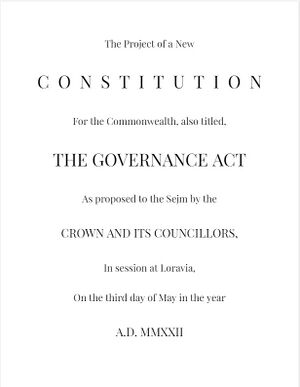Constitution of Cheskgariya-Litvania
| Governance Act | |
|---|---|
| Overview | |
| Jurisdiction | Cheskgariya-Litvania |
| Created | 27 January 2021 |
| Presented | 30 June 2022 |
| Ratified | 8 July 2022 |
| Date effective | 9 July 2022 |
| System | Federal parliamentary elective monarchy |
| Government structure | |
| Branches | 3 |
| Chambers | Unicameral |
| Executive | Co-Monarchs and the Crown Council |
| Judiciary | Supreme Court |
| Federalism | Yes |
| Electoral college | No |
| Entrenchments | 13 |
| Author(s) | Michal Nowacki Charles Burgardt |
| Signatories | Crown Council Sejm |
| Media type | Digital |
| Supersedes | Governance Act (2021) |
The Constitution of Cheskgariya-Litvania, also the Governance Act, is a piece of legislation from the Cheskgariyan-Litvanian Commonwealth, intended to act as a constitutional document and to set a basic structure of the government and operations of the government of the nation.
It is divided into thirteen different sections discussing different aspects of the nation's governance or structure.
It was created by Frederick Augustus, Grand Duke of Litvania, with help from his co-monarch Charles, King of Cheskgariya. Work officially began on the 27 January 2022, and the document was completed in mid-April, being presented to and ratified by the Crown Council on 30 June 2022.
Contents

The document begins with a short preamble:
Recognising that achieving full national happiness and efficiency depends solely upon the establishment and perfection of a national constitution, having by long experience learned the inveterate faults in our government, and wishing to rectify these problems, holding dearer than life, than personal happiness the political existence and external independence of the people whose destiny had been entrusted into our hands, and in wishing to secure the gratitude of contemporary and future generations we do for the general welfare, for the establishment of liberty, for the common defence, despite obstacles that cause passions in us, hereby ordain this Constitution to be entirely sacred and inviolable, until the people, at a time by the law prescribed, shall feel the need to alter any of its articles.
— Michal Nowacki, Charles Burgardt, Governance Act, Preamble
Article I. Religion
The first article establishes the Commonwealth as a secular entity, establishes freedom of religion, and prohibits the creation of state churches or other religious institutions.
Article II. Government, or The Designation of Public Authorities
The second article outlines the three branches of government: the executive (The Crown and Crown Council), the legislative (the Sejm), and the judicial branch.
Article III. The Monarchy and Government, or The Executive Authority
The longest article of the document, the third article describes the executive branch of the government in more detail. It establishes the monarchy as the primary form of executive government in the Commonwealth, to be aided and checked by the Crown Council. The powers of the monarchy are precisely laid out, and the composition of the Crown Council is described. Procedures for non-confidence as well as removal of Crown Councillors are described. Further clauses regarding relations with the Sejm are laid out. Procedures for Council votes are described. Finally, a clause describing ultimate obedience to the executive branch is included, which also includes a list of limits and non-powers of the executive branch.
Article IV. The Sejm, or The Legislative Authority
The Sejm (parliament) is established as the sole legislative body in the nation. The article lays out what kind of laws it may deal with, and includes a priority token for Crown bills. Procedures for voting are laid out, and the procedure for amendments of the Constitution.
Article V. The Judicial Authority
The article establishes the Supreme Court of the Commonwealth, it's highest office of Supreme Justice, and includes provisions on basic legal principles, such as neminem captivabimus.
Article VI. The Regency
Provisions regarding a regency situation.
Article VII. The National Armed Forces
Provisions regarding the military.
Article VIII. The Nobility
Basic provisions regarding the status of nobility in the nation.
Article IX. Territorial Definition and Extent
Establishes the territory of the Commonwealth, and grants Free Royal City status to both Loravia and Ugsarn.
Article X. The States & Their Powers
Reaffirms the federal character of the Commonwealth, by allowing the States to elect their own Sejmiks, and conduct internal policy through state-level cabinets.
Article XI. Citizenship and Residency
Affirms the individual's right to select their state of residence, and right to naturalization. Also privileges land grants by conferring nobility.
Article XII. Nomenclature
Provisions regarding the specific naming of the union.
Article XIII. Ratification & Promulgation
Establishes conditions for the official ratification and promulgation of the Constitution into law.